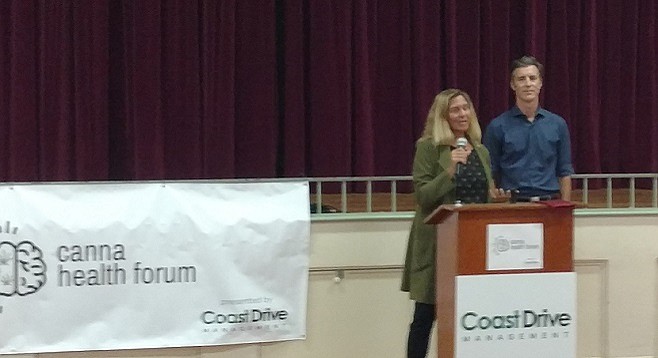 Facebook
Facebook
 X
X
 Instagram
Instagram
 TikTok
TikTok
 Youtube
Youtube

While Californians as a whole have shifted their marijuana consciousness in recent months to freshly-legalized recreational pot, a pair of local doctors are among those continuing to explore the plant's medicinal properties.

On Wednesday evening (April 4), a crowd of about 50 people, most with ties to medical cannabis dispensaries, trickled into the San Diego Indoor Sports Club in Mission Hills for a discussion panel on the usefulness of marijuana in lessening reliance on opiates.
About half of attendees were late arrivals, causing an advertised six o'clock start time to be pushed back half an hour. Those more prompt were left to browse tables promoting, among other things, a group advocating for delivery-based dispensaries (which have been largely left out of zoning and licensing talks throughout the county), cannabis pet products, and a consulting service offering dosing advice for new medical marijuana users. Following promotional pitches, including one from Lori Saldaña, whose latest political ambition is a seat on the county board of supervisors, Drs. Michelle Sexton and Jamie Corroon settled into their talk.
"Both opium and cannabis have been used for a very, very long time," began Sexton, an adjunct professor in UC San Diego's medical department. "There are indications that a combination developed by the Chinese may have been used as one of the first forms of anesthesia thousands of years back.
"In the 1800s, the active component of the opium-producing poppy was isolated, and that's what allowed opium to become a medicine that was widely used. Conversely, the main active component [of cannabis], THC, wasn't isolated until 1964 – this explains why cannabis kind of fell out of repute as a medicine in the early 1900s. People just felt more comfortable having a chemically predictable measure of how potent something was."
Sexton went on to explain that the body contains both opiate and cannabinoid receptors that provide for uptake of and reaction to the drugs.
"One of the first things they did once THC was isolated was to prepare a paper exploring whether it would bind with opiate receptors," she continued. Tests on mice found that those exposed to THC were less sensitive to changes in temperature and exposure to painful situations such as contact with a hot plate.
"There's evidence that THC has an affinity for two of the three opiate receptors, which makes them develop a higher affinity for opioids," explained Corroon, founder of the Center for Medical Cannabis Education, explaining why in the past the two may have been used in conjunction. "THC can prime the opiate receptor for opioids."
This is important, the pair explain, because it can allow patients to use lower doses of prescription painkillers at less frequent intervals, avoiding or lessening the risk of opiate-related maladies including decreased respiratory function, constipation, sexual dysfunction, nausea and vomiting, wasting of muscle tissue and, in a nod to the country's ongoing opioid crisis, physical addiction and withdrawal symptoms.
"To give a sense of the magnitude of the crisis," Corroon continued, "the most common cause of accidental death in the country is drug overdose. Sixty-six percent of all drug overdoses are opioid-related – that's 42,000 opiate deaths in 2016. Forty percent of those are from prescription drugs – some people question whether you should include the non-prescription opioids in these numbers, whether we should think about them the same way. I think we should, because when you look at people who are abusing and dying from non-prescription opioids, over 80 percent of them will say that the first time they tried an opiate it was prescribed by a doctor.
"Is cannabis the answer? No – this problem is far too complex for one single solution. But I believe that, for sure, cannabis is part of the answer."
Per Corroon, research surveys have consistently shown that of the 50-60 percent of marijuana users that state they're consuming the plant for medical purposes, pain relief is among the top reasons listed for the medical need, and that users report reducing their use of pharmaceutical painkillers after implementing a cannabis regimen.


While Californians as a whole have shifted their marijuana consciousness in recent months to freshly-legalized recreational pot, a pair of local doctors are among those continuing to explore the plant's medicinal properties.

On Wednesday evening (April 4), a crowd of about 50 people, most with ties to medical cannabis dispensaries, trickled into the San Diego Indoor Sports Club in Mission Hills for a discussion panel on the usefulness of marijuana in lessening reliance on opiates.
About half of attendees were late arrivals, causing an advertised six o'clock start time to be pushed back half an hour. Those more prompt were left to browse tables promoting, among other things, a group advocating for delivery-based dispensaries (which have been largely left out of zoning and licensing talks throughout the county), cannabis pet products, and a consulting service offering dosing advice for new medical marijuana users. Following promotional pitches, including one from Lori Saldaña, whose latest political ambition is a seat on the county board of supervisors, Drs. Michelle Sexton and Jamie Corroon settled into their talk.
"Both opium and cannabis have been used for a very, very long time," began Sexton, an adjunct professor in UC San Diego's medical department. "There are indications that a combination developed by the Chinese may have been used as one of the first forms of anesthesia thousands of years back.
"In the 1800s, the active component of the opium-producing poppy was isolated, and that's what allowed opium to become a medicine that was widely used. Conversely, the main active component [of cannabis], THC, wasn't isolated until 1964 – this explains why cannabis kind of fell out of repute as a medicine in the early 1900s. People just felt more comfortable having a chemically predictable measure of how potent something was."
Sexton went on to explain that the body contains both opiate and cannabinoid receptors that provide for uptake of and reaction to the drugs.
"One of the first things they did once THC was isolated was to prepare a paper exploring whether it would bind with opiate receptors," she continued. Tests on mice found that those exposed to THC were less sensitive to changes in temperature and exposure to painful situations such as contact with a hot plate.
"There's evidence that THC has an affinity for two of the three opiate receptors, which makes them develop a higher affinity for opioids," explained Corroon, founder of the Center for Medical Cannabis Education, explaining why in the past the two may have been used in conjunction. "THC can prime the opiate receptor for opioids."
This is important, the pair explain, because it can allow patients to use lower doses of prescription painkillers at less frequent intervals, avoiding or lessening the risk of opiate-related maladies including decreased respiratory function, constipation, sexual dysfunction, nausea and vomiting, wasting of muscle tissue and, in a nod to the country's ongoing opioid crisis, physical addiction and withdrawal symptoms.
"To give a sense of the magnitude of the crisis," Corroon continued, "the most common cause of accidental death in the country is drug overdose. Sixty-six percent of all drug overdoses are opioid-related – that's 42,000 opiate deaths in 2016. Forty percent of those are from prescription drugs – some people question whether you should include the non-prescription opioids in these numbers, whether we should think about them the same way. I think we should, because when you look at people who are abusing and dying from non-prescription opioids, over 80 percent of them will say that the first time they tried an opiate it was prescribed by a doctor.
"Is cannabis the answer? No – this problem is far too complex for one single solution. But I believe that, for sure, cannabis is part of the answer."
Per Corroon, research surveys have consistently shown that of the 50-60 percent of marijuana users that state they're consuming the plant for medical purposes, pain relief is among the top reasons listed for the medical need, and that users report reducing their use of pharmaceutical painkillers after implementing a cannabis regimen.
Comments